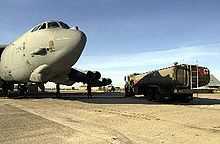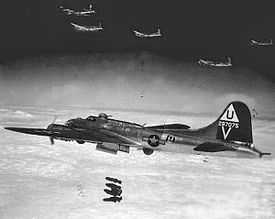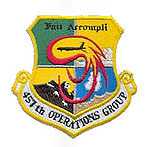457th Air Expeditionary Group
| 457th Air Expeditionary Group | |
|---|---|
 Emblem of the 457th Air Expeditionary Group | |
| Active | 1943–1945; 1993–1994; 2003 |
| Country | United States |
| Branch | United States Air Force |
| Garrison/HQ | Air Combat Command |


The United States Air Force's 457th Air Expeditionary Group is a provisional United States Air Force unit assigned to the Air Combat Command. The 457 AEG may be activated or inactivated at any time.
Its last assignment was to the United States Central Command Air Forces, being stationed at RAF Fairford, England, for duty during Operation Iraqi Freedom in 2003. It was inactivated sometime after the active combat phase of the operation ended.
During World War II, its predecessor unit, the 457th Bombardment Group (Heavy) was an Eighth Air Force B-17 Flying Fortress unit stationed in England. Assigned to RAF Glatton in early 1944, the group carried out 236 combat missions over Occupied Europe and Nazi Germany. Total number of sorties was 7,086 with nearly 17,000 tons of bombs and 142 tons of leaflets being dropped.
History
Lineage
- Established as 457th Bombardment Group (Heavy) on 19 May 1943
- Activated on 4 July 1943
- Inactivated on 28 August 1945
- Redesignated 457th Operations Group and activated on 1 July 1993
- Inactivated on 1 October 1994
- Redesignated 457th Air Expeditionary Group and converted to provisional status in 2003
Assignments
- II Bomber Command, 4 July 1943
- Second Air Force, 6 October 1943–1 January 1944
- 94th Combat Bombardment Wing, 21 January 1944–1 July 1945
- Army Service Forces (for inactivation), 20 July–28 August 1945
- 19th Air Refueling Wing, 1 July 1993–1 October 1994
- Air Combat Command to activate or inactivate at any time after 2003 (Date TBD)
Components
- 11th Air Refueling Squadron, 1 July 1993–1 October 1994
- 23d Bomb Squadron (Attached), 2003 (Dates TBD)
- 748th Bombardment Squadron: 4 July 1943–28 August 1945 (Red Prop Boss)
- 749th Bombardment Squadron: 4 July 1943–28 August 1945 (Blue Prop Boss)
- 750th Bombardment Squadron: 4 July 1943–28 August 1945 (White Prop Boss)
- 751st Bombardment Squadron: 4 July 1943–28 August 1945 (Yellow Prop Boss)
Stations
- Geiger Field, Washington, 4 July 1943
- Rapid City Army Air Base, SD, 9 July 1943
- Ephrata Army Air Base, Washington, 28 October 1943
- Wendover Field, Utah, 4 December 1943–1 January 1944
- RAF Glatton (USAAF Station 130), England, 22 January 1944–1 June 1945
- Sioux Falls Army Air Field, South Dakota, 20 July–28 August 1945
- Altus AFB, Oklahoma, 1 July 1993–1 October 1994
- RAF Fairford, England, 2003 (Dates TBD)
Aircraft
- Boeing B-17 Flying Fortress 1943–1945
- Boeing KC-135 Stratotanker, 1993–1994
- Boeing B-52 Stratofortress (2003)
Operational history
World War II


Constituted as the 457th Bombardment Group (Heavy) on 19 May 1943. Activated on 1 July 1943. Trained for combat with B-17's.[1] Moved to RAF Glatton England, January–February 1944, and assigned to Eighth Air Force. The group was assigned to the 94th Combat Bombardment Wing of the 1st Bombardment Division. Its tail code was Triangle-U.
The 457th Bomb Group consisted of the following operational squadrons:
The 457th Bomb Group flew its first mission on 21 February 1944[2] during Big Week, taking part in the concentrated attacks of heavy bombers on the German aircraft industry. Until June 1944, the Group engaged primarily in bombardment of strategic targets, such as ball-bearing plants, aircraft factories, and oil refineries in Germany.
The Group bombed targets in France during the first week of June 1944 in preparation for the Normandy invasion, and attacked coastal defenses along the Cherbourg peninsula on D-Day. Struck airfields, railroads, fuel depots, and other interdictory targets behind the invasion beaches throughout the remainder of the month.
Beginning in July 1944, the 457th resumed bombardment of strategic objectives and engaged chiefly in such operations until April 1945. Sometimes flew support and interdictory missions, aiding the advance of ground forces during the Saint-Lô breakthrough in July 1944 and the landing of British 1st Airborne Division during the airborne attack on Holland in September 1944; and participating in the Battle of the Bulge, December 1944 – January 1945, and the assault across the Rhine in March 1945. The Group flew its last combat mission, number 236, on 20 April 1945.[3]
After V-E Day, the 457th transported prisoners of war from Austria to France, and returned to Sioux Falls Army Airfield, South Dakota, during June 1945.
The 457th was inactivated on 18 August 1945.[4]
Empire State Building
On Saturday, 28 July, Lieutenant Colonel William F. Smith lost his way while ferrying a B-25 Mitchell bomber from Bedford, Massachusetts, to Sioux Falls AAF via Newark Airport. Emerging from low cloud at about 9,000 feet (2,700 m) the 457th pilot found himself among the skyscrapers of midtown Manhattan. The aircraft crashed headlong into the 79th floor level of the Empire State Building, killing Lieutenant Colonel Smith, two passengers and eleven office workers. The B-25 exploded on impact spraying burning fuel into 34th Street below, one of the engines completely passing through the building and out the other side.[5]
Modern era

During 1 July 1993 – 1 October 1994, the 457th Operations Group was an operational component of the 19th Air Refueling Wing, with its headquarters at Altus AFB, Oklahoma. The 457th operated the 11th Air Refueling Squadron and 306th Air Refueling Squadron, flying KC-135R Stratotankers in Southwest Asia from Aviano Air Base, Italy, and Incirlik Air Base, Turkey, supporting Operation Northern and Operation Southern Watch duties as the lead tanker unit.
War on Terrorism
The 457th Air Expeditionary Group was activated as a combat unit as part of the Global War on Terrorism, to support Operation Iraqi Freedom. It is known that the group supported B-52 Stratofortresses operations, using B-52Hs attached from the 23d Bomb Squadron, Minot AFB, North Dakota, and USAF Reserve 917th Wing, Barksdale AFB, Louisiana. The B-52s operated from a "forward deployed location", which was RAF Fairford, England. The unit inactivated sometime after Operation Iraqi Freedom ended active combat operations.
References
![]() This article incorporates public domain material from websites or documents of the Air Force Historical Research Agency.
This article incorporates public domain material from websites or documents of the Air Force Historical Research Agency.
Notes
Bibliography
- Angier, Major (Ret) J. Francis. Ready or Not – Into the Wild Blue: The Aviation Career of a B-17 Pilot, 457th BG, 8th AAF. South Burlington, Vermont: Success Networks International, 2003./Cowbit, Lincolnshire, UK: Old Forge Publishing, 2005. ISBN 0-9544507-7-9.
- Bass, James L. Fait Accompli: A Historical Account of the 457th Bomb Group. Carthage, TN: JLB Publications, 1995. ISBN 0-9648925-0-2.
- Bass, James L. Fait Accompli II: A Historical Account of the 457th Bomb Group. Carthage, TN: JLB Publications, 1998. ISBN 0-9648925-1-0.
- Bass, James L. Fait Accompli III: A Historical Account of the 457th Bomb Group. Carthage, TN: JLB Publications, 2000. ISBN 0-9648925-2-9.
- Blakebrough, Ken. The Fireball Outfit: The 457th Bombardment Group in the Skies Over Europe. Fallbrook, California: Aero Publishers, Inc., 1968. ISBN 0-8168-9754-9.
- Byers, Roland O. Black Puff Polly. Moscow, Idaho: Pawpaw Press, 1991. ISBN 0-9614563-2-9
- Byers, Roland O. Flak Dodger. Moscow, Idaho: Pawpaw Press, 1985. ISBN 0-9614563-0-2.
- Freeman, Roger A. and Winston G. Ramsey. Airfields of the Eighth: Then and Now. London: After the Battle, 1978. Republished 1992.
- Freeman, Roger A. The Mighty Eighth: Units, Men and Machines – A History of the US 8th Air Force. 1970. ISBN 0-87938-638-X.
- Revised as The Mighty Eighth: a History of the Units, Men and Machines of the US 8th Air Force. Cassell & Co., 2000. ISBN 1-85409-035-6.
- Freeman, Roger A. The Mighty Eighth in Colour. London: Arms & Armour, 1991.
- New Edition as The Mighty Eighth: The Colour Record. London: Cassell & Co., 2001. ISBN 0-304-35708-1.
- Freeman, Roger A. The Mighty Eighth War Diary. London: Jane's Publishing Company, 1981.
- Freeman, Roger A. The Mighty Eighth War Manual. London: Cassell & Co., 2001. ISBN 0-304-35846-0.
- Freeman, Roger A. The Mighty Eighth: Warpaint and Heraldry. London: Arms & Armour, 1997.
- Maurer, Maurer. Air Force Combat Units Of World War II. Maxwell Air Force Base, Montgomery, Alabama: Office of Air Force History, 1983. ISBN 0-89201-092-4.
- Weingarten, Arthur. The Sky is Falling – Plane Crash at Empire State Building. New York: Grosset & Dunlap, 1977. ISBN 0-448-14411-5.
- Welch, John F. Dead Engine Kids. Rapid City, South Dakota: Silver Wings Aviation, Inc., 1993. ISBN 0-9637909-0-0.
External links
- 457th Bomb Group Association
- 457th Bomb Group Association (older version)
- 8th Air Force Historical Society, 457th Bomb Group
- RAF Glatton Control Tower
- 457th Bomb Group Memorial Statute at All Saints Church, Conington, Huntingdonshire
| |||||||||||||||||||||||||||||||||
